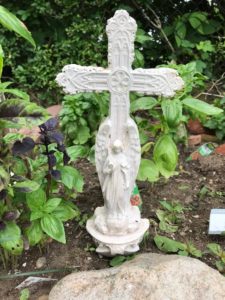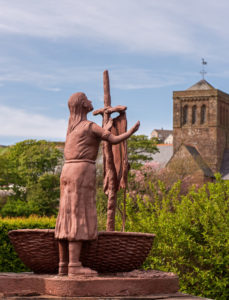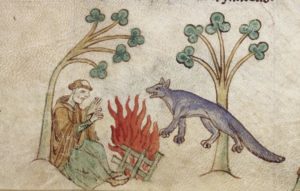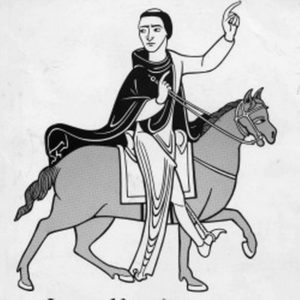
For me, God and Nature are intricately bound. I feel God in a storm. I am in awe of God in a mountain. But I love God in the serenity of a garden. My restless soul is at peace in its borders.

I had originally planned to construct a “Biblical herb garden” or a monastery herb garden, but I dispensed with the raised bed and the limited selection of herbs. I wanted to include tomatoes and peppers, so good to eat in summer. The borders are rocks and old bricks or pieces of brick I picked up during walks along Peconic Bay. I threw in some oyster shells and interesting pieces of driftwood. 
My garden is a balance of religion and whimsy– full of herbs, gnomes, saints, cement ducks, vegetables and sayings by spiritual people. The quotes serve to remind me of Catholicism’s spiritual connection to Nature, and the presence of God in everything around us. My favorites are: “We always plant better than we know.” – Sr. Julia McGroaty, a founder of Trinity College, Washington, DC (my alma mater). “God is a God of Surprises.” – Pope Francis. “Remember who you are and whose you are.” – Sr. Thea Bowman, a religious woman I admire for her courage, patience, and faith. I hope she is named a saint.


I have had a number of thought and soul changing experiences with animals. I loved like a family member most of our dogs–especially Winston and Cutie. Constant in their affections, they taught me love and emotions are not limited to human beings. DOG really is GOD spelled backwards. Seeing a great horned owl against the moon in Pennsylvania is an image that will always stay with me. Hand feeding two baby robins from a ruined nest was a bonding experience. I wanted them to remain wild, so I never named them or kept them in the house. Each night I would put them in a short white pine to roost. I could recognize their peeps above the forest cacophony. I was sad when they departed, but happy I helped them to live. From time to time I would see a robin come close and look at me intently. I wondered if that was one of them, or one of their babies coming to check out the legend of the Mother Giant who brought their ancestors from Bay Ridge, Brooklyn and fed them worms, oatmeal and mashed cherries. 
In March 2019 I met Maurice at the Kanaloa Octopus Farm in Kailua-Kona, Hawaii. This aquaculture project began in an effort to help preserve and increase the declining reef octopus populations. A demand for octopus for food and bait has had a severe impact on their numbers. Scientists are trying to learn how to successfully breed octopuses for food and fishing and leave the wild ones alone. They are making progress, but haven’t been successful yet.
Maurice was rescued from a fishing boat where he was about to become bait or dinner. He is now part of the Kanaloa experiment. Visitors to Kanaloa get to interact with the octopuses. We discovered each one has their own individual traits and personalities. Some are curious, shy, grumpy, reclusive, aggressive, clever or playful. I’m sure there are more parts of their character, but those are the ones I observed in my hour at the aquaculture farm. 
After wiggling my fingers in the water to mimic a fish, Maurice came up from the bottom of his tank to investigate. He gently touched my fingers. I gently touched his tentacle. It was very smooth. The encounter reminded me of the fresco painting of Adam and God in the Sistine Chapel. One touch changed everything.
Ever since I met Maurice I cannot eat octopus and would never use them for bait.


I recently helped to plant dune grass along the shoreline of Window’s Hole in Greenport. The grass will help preserve the beach in storms. The project is sponsored by the Peconic Land Trust, based in Southampton, NY and serving the Twin Forks of Long Island.
Widow’s Hole Preserve lies on top of an old marine Esso station that used to serve the fishing fleet in Greenport decades ago. It was abandoned, and finally donated to the nonprofit in lieu of cleaning up the old underground tanks. They are probably better off left undisturbed.
Widow’s Hole is a wonderful place to walk and view part of Peconic Bay, Shelter Island, Greenport and the neighboring oyster farm. The volunteer work was satisfying physically and spiritually. I loved the idea of planting grass that one day I would see waving in the breeze. It felt good to restore shoreline habitat. But I liked most of all the spirituality that accompanied the planting, and the wonderful feeling of wholeness and connection in surveying the finished work and bay.


St. Bega is an ancient Irish saint whose life is steeped in legend and mystery. She lived between 700-900 A.D., probably closer to 850 AD and the time of Viking settlement in Ireland. Bega was the daughter of an Irish king. She is described as beautiful, virtuous and learned. Her father had promised her to the son of the King of Norway, but Bega had no intention of marrying. She consecrated her virginity to Christ. According to one story, an angel presented Bega with an arm ring inscribed with the cross as a token of her sacred promise. Arm rings were usually worn by men, not women.
On the night of her wedding Bega was desperate to escape. All the doors in the palace were locked, and the strongest men of Ireland standing guard, “each with a dagger over his thigh, a double-edged axe over his shoulder and a spear in his hand.” (Very phallic symbols!) After a lengthy invocation by Bega, a holy voice directs her out of the palace while everyone else is drunk at a feast. All of the locks yield at the touch of the holy arm ring, and a boat is waiting for her at the shore. In another account, Bega is transported across the Irish Sea by a clod of soil. She arrives safely on the English coast at Cumbria. Settling there, Bega lived in strict seclusion in a hut she built in a grove of trees near the seashore. She survived on food brought to her by seagulls and gannets. 
After some years passed Viking pirates began to raid the coast. Fearing rape and the loss of her virginity, Bega left her hermitage and traveled inland. On the advice of King Oswald (later St. Oswald), she professed her religious vows, and established a monastery at St. Bees in Cumbria. 
What became of her magical arm ring? In one story she leaves her arm ring behind as a future source of miracles. In another her arm ring was preserved as a holy relic at St. Bees. St. Bega is credited with restoring the sight of a blind Irish boy; gifting a Galloway horse thief with an ass full of arrows, and killing by a disfiguring disease a detachment of soldiers who raped a nobleman’s virgin daughter.
The Registry of St. Bees’ Priory records the swearing of oaths on the “Bracelet of St. Bega” through 1279, and offerings to the arm ring were made as late as 1516.
The arm ring may have disappeared during King Henry VIII’s Dissolution of the Monasteries in the 1540s; or, it may have been looted by the Scottish knight, Lord James Douglas during a raid in 1315.
Read more about St. Bega on these sites:
Esmeralda’s Cumbrian History and Folklore
St. Bees Village Website
St. Bega – Cumbria and Borders
Baldy Blog – St. Bees Priory
Saint Natalis of Ulster (also spelled Naile, Naul, Naal) died in 563 or 564 A.D. He was a monk, abbot and contemporary of Saint Columcille. Natalis was a student of Columcille (Columba). and founded monasteries throughout Ulster, serving as abbot at St. Naul’s Abbey, Inver, Kinawley (Cill Naile), Inver Naile at Raphoe, County Donegal; and Devenish Island, County Fermanagh. The handle of a bell given to him by Saint Columcille was preserved at the church in Kinawley up to the 19th century. 
Saint Natalis appears in the Martyrology of Donegal (Calendar of Saints) written and compiled by Mícheál Ó Cléirigh around 1630. In the chronicle the stories about St. Natalis allude to his temper. Frustrated and thirsty, he flung his crozier at a rock pile. Miraculously, a stream of pure spring water began to flow. The spot became known as Cill Naile. The saint was was a dangerous man to cross. He cursed his enemies and people who opposed him. “I curse that Murchad with his descendants; defect of carving on his carving, and on himself, and on his families after him.”
According to legend, St. Natalis placed a curse on a clan which transformed their members into werewolves. Here is the tale:

An unnamed priest was traveling from Ulster to Meath on an important mission with his assistant, a young boy. The two stopped for the night near woods at the edge of the See of Ossory. As they lay down to sleep, the priest hears a human voice calling from the nearby forest. He gets up and looking out into the darkness and sees a giant wolf draw near. The priest and boy draw back in horror, but the wolf speaks in a human voice and tells them not to be afraid.“We are natives of Ossory,” the wolf said, “From there every seven years, because of the imprecation of a certain saint, namely the Abbot Natalis, two persons, a man and a woman, are compelled to go into exile not only from their territory but also from their bodily shape.” “But how came you by this fearsome form?” the priest asked in wonder. “And why must you wear it for seven years?” “I am a member of Clan Allta, a tribe of this region,” the wolf answered, “and like yourself, Father, we are believers in Jesus Christ and in the power of His salvation. However, in times long past, we were cursed for some ancient sin by the blessed Abbot Natalis.” The priest had heard of Natalis, who had come to Ireland shortly after the Blessed Patrick to bring the Word of God to a dark and pagan land. He had even read some of the holy man’s works. From what he had read, he had always imagined Natalis to be exceedingly severe and inflexible in his teachings and one who would brook no deviation from his own interpretations of God’s law.
“The sin which my clan committed has long been forgotten,” said the wolf, “but the curse is still in force. Every seven years two of us must lose our mortal form to wear the skin of a wild wolf and must live in the deep woods away from our clan. When the seven years are up we shed our animal form and regain our human shape and two others must take our place. It is a terrible burden, Father, and one that will never be lifted, for Natalis is long dead.” 
The wolf asks the priest accompany him into the woods to give the last rites to his mate, the female wolf. The priest is filled with terror that the wolf will kill him, but follows the wolf into the woods. He gives the dying wolf communion and blesses her. The male wolf returns the priest to his campfire and bids him farewell, loping back into the forest. The priest calls out after him saying he would return. On his way back to Ulster, the priest stopped in the woods of Ossory and searched for the werewolves but did not find any trace of them.
Saint Patrick and Saint Natalis are sometimes confused in the werewolf story. In one account, “it is told when the holy Patricius (St. Patrick) preached Christianity in that country, there was one clan which opposed him more stubbornly than any other people in the land; and these people strove to do insult in many ways both to God and to the holy man. And when he was preaching the faith to them as to others and came to confer with them when they held their assemblies, they adopted the plan of howling at him like wolves.”
St. Patrick responded by praying to God to punish the clan, resulting in them suffering “a fitting and severe through marvelous punishment, for it is told that all the members of the clan are changed into wolves for a period and roam through the woods feeding upon the same food as wolves; but they are worse than wolves, for in all their wiles they have the wit of men, though they are as eager to devour men as to destroy other creatures.”
Saint Natalis (Naal) and the Werewolves first appeared in Gerald of Wales’ Topographia Hibernica, written in 1185 A.D. The incident with the werewolves and the priest was supposed to have occurred two years before Gerald’s visit to Ireland with King John in 1175 A.D. While he was in Ossory, Gerald was approached by two priests sent by the bishop to ask him his view on this “serious matter.” Gerald met with the Bishop of Ossory and set down the story in writing, which was sent to Pope Urban III. It became one of the first werewolf stories ever recorded. A Norse work written about 1250 A.D., Konungs Skuggsja (King’s Mirror), describes Irish werewolves as being humans who were cursed as a divine punishment for wickedness. The tale is clearly based on the Ossory werewolves. 
The story of Saint Natalis and the Ossory Werewolves can also be found on Omnium Sanctorum Hiberniae, Library Ireland – The Wonders of Ireland, and Dark Emerald Tales.


















